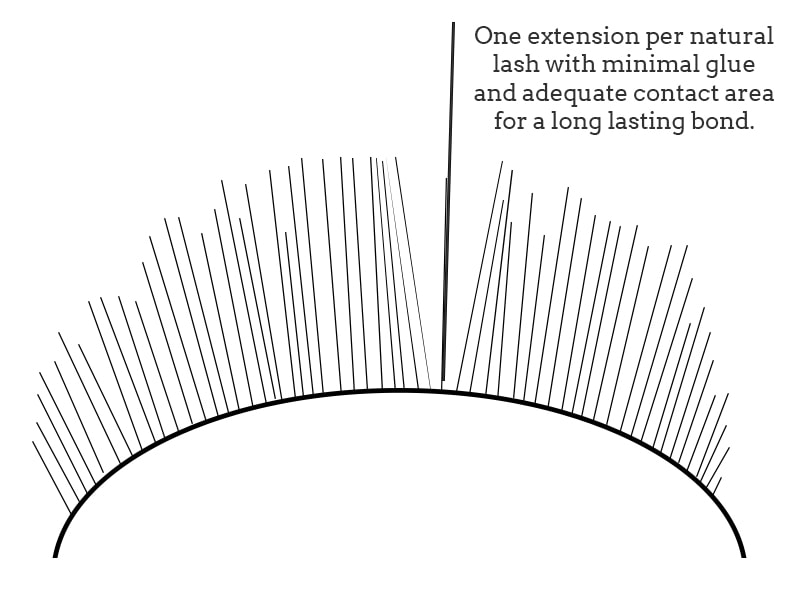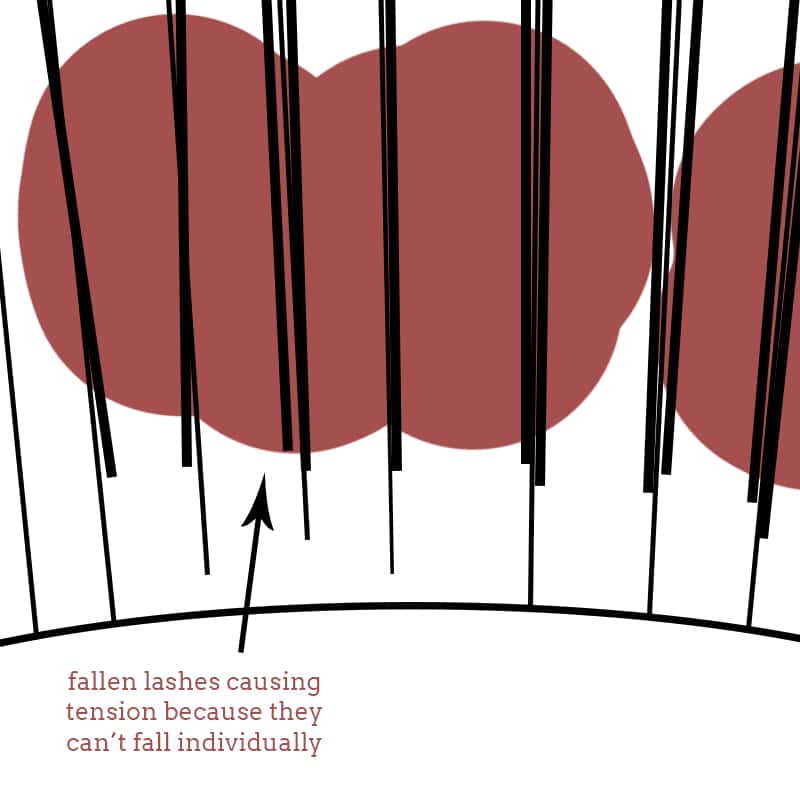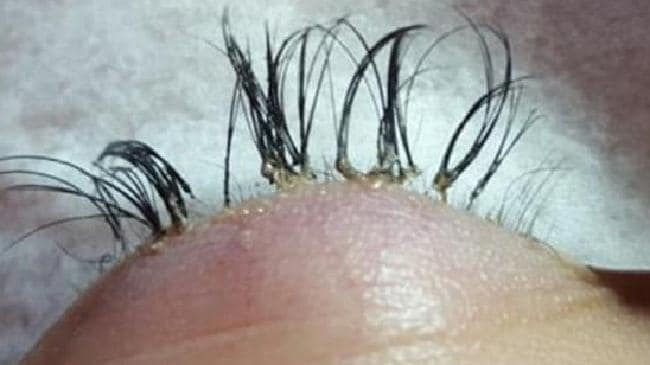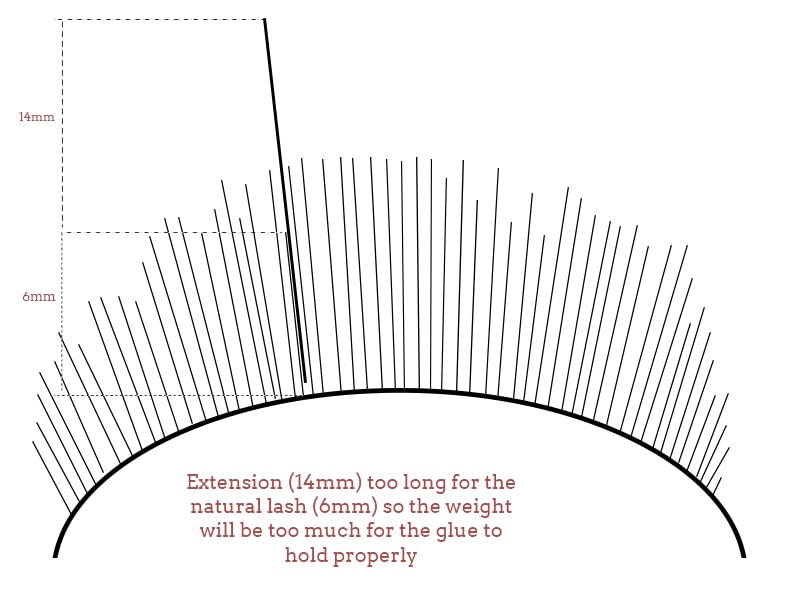Getting your lash extensions infilled every two to three weeks is the perfect way to keep your lashes looking perfect, but when new clients with lashes from other salons want to book infills I often recommend a removal and a new full set…
and in this article I’ll explain why 🙂
Every eyelash extension salon is a little different, and each lash tech within a salon is too. The standards of extensions, glue and technique all differ dramatically (see the repair section of my gallery for examples) – that’s why there can be HUGE variations in price when you shop around.
When I’m contacted by a new client for infills who has had their previous set of extensions applied at another salon I always ask for a photo, so I can see what I’ll be working with, and if it will even be possible for me to infill. Here’s a breakdown of…
The 3 Problems When Infilling Other Salons’ Extensions
They Used Too Much Glue
This is a trademark of either poorly trained lash tech’s, or those put under a serious time crunch!
When eyelash extensions are done right there should be only one extension added to one of your strong and healthy natural lashes…
The process is something like this:
- the natural lash needs to be separated
- the extension is lightly coated in a high quality glue
- extension gets applied to your natural lash
- a few seconds of drying time is allocated before moving on the next lash [diagram below].

This process is time consuming, but it gives you that ‘natural’ feeling – where your lashes don’t feel heavy, and you can still brush through them with a lash comb. The amount of glue used is minimal and so fine that it’s difficult to see or feel.
It’s also the safest way to apply lashes because it doesn’t put addition strain on your natural lash. When the natural lash reaches the end of it’s growth cycle and falls out (exactly what you want) – it won’t pull any other lashes with it. Brilliant!
BUT poorly trained lash technicians, or those being forced by the business owner to pump out as many sets of extensions as possible in the shortest amount of time will often take big shortcuts…
They’ll pile on loads of glue, won’t take the time to separate lashes and drop multiple lashes on at a time, allowing them to create a thick, full look in less time [diagram below].

The problems begin shortly after when your natural lashes start to fall out (like they would even without extensions), but because they’re clumped together with glue they get stuck in place. The added weight of these glue/lash clumps puts added tension on your remaining natural lashes which leads to premature lash fall.
This means your natural lashes literally get ripped out of your eyelid. This can cause irritation for some people, but others will just notice their natural lashes looking more sparse [diagram below].

In the diagram you can see the 3 natural lashes that have reached the end of their growth cycle and fallen out, BUT they’re glued in a clump with other natural lashes and extensions, putting a lot of tension on the 2 natural lashes that are still attached on the outside – this tension will generally cause those lashes to rip out, leaving the client with very few natural lashes by the time their extensions have fallen out – making it extremely difficult to infill or get a new set (because there’s no strong lashes left to put extensions on to).
Here’s an extreme example (be warned – it’s pretty gross!)

I can’t infill these clumpy lashes because it basically doesn’t look great and isn’t up to my high standards, and because of big gaps where there’s no healthy lashes the final result will look gappy and unnatural.
Some salons will simply sidestep the issue by adding more extensions to baby lashes in the early phase of their growth cycle, but this just makes the problem worse!
If I infill these clumpy extensions it’s like big clumps of glue and imprecisely adhered lashes, surrounded by the lashes I apply which look natural, fluffy and light. It just doesn’t look right!
The next problem is that the…
Natural Lashes Are Badly Damaged
I touched on this above, but damaged natural lashes are caused by extensions being applied with too much glue, or extensions that are too heavy being applied to natural lashes that can’t support them.
We all have different lashes, and if your natural lashes are short and fine I wouldn’t adhere a long thick extension because there wouldn’t be enough contact area to get a good bond, AND the weight of the extension on your natural lash could result in premature lash fall.

The point being that if your natural lashes are too damaged I would advise waiting a few weeks before getting a new set of extensions to give your natural lashes time to regenerate.
If your natural lashes are damaged and you still have bad extensions remaining I recommend doing a home removal to try and salvage the strong lashes you still have (I’ll explain this procedure a little further on).
Which brings me to the final type of extensions I won’t infill…
Extensions That Are Too Thick or Too Long (Or Both!)
As mentioned above, it can be a big problem if extensions are applied too thick or heavy because even if they’re done properly with one extension per healthy natural lash, they can still cause premature lash fall because of the weight – or the extensions can lose their bond because of the insufficient contact area.
After a lot of experience applying lashes, and having long term repeat clients I’ve developed a good sense of what a natural lash can hold to keep it healthy and avoid any unnecessary strain…
I’d never put a 14mm 6D extension on a small, fine natural lash because there’s a good chance either the bond would fail, or the natural lash would come out earlier than it should have.
So the reason I’d recommend a new set instead of infills is that let’s say you do have naturally short lashes – if the previous lash tech has added heavy 14mm long, thick single mink lashes, I might see that your natural lash should only hold a maximum of a 10mm extension, so there will be a disparity between the 14mm and 10mm lashes…
In some situations, this can look ok, for example, if you’re going for the baby doll style, but it’s on a case-by-case basis.
If you’re not sure what condition your lashes are in, and would like to book with me, then just send me a photo and we can discuss your options further!
Or if you know for sure that you’ll need a removal, then let’s talk about the lash removal process…
The Lash Extensions Removal Process
I always recommend an at-home removal if possible for a few reasons…
First is because it’s free, and second is because it’s MUCH gentler on your eyes and skin with less chance of irritation or reactions.
To remove your extensions at home
- get some normal olive oil
- put it between your thumb and index finger and massage it gently into your lashes
- keep going until you feel the extensions pulling away
- be patient – it can take a while!
The oil will gradually loosen the bond of the glue and cause the extensions to separate from your natural lashes.
Alternatively, you can have them removed in the salon before getting a full set (make sure you let me know it’ll be a removal plus a full set). The process can take up to 30 minutes and involves using a special chemical to more quickly release the bond of the glue, followed by a cold water rinse and clean with saline solution. This process is repeated until all the extensions and traces of glue have been removed.
The caveat is that the glue removal chemical, like most chemical around the eye, has the possibility for causing irritation to the surrounding skin and even though the solution won’t go in your eye, the fumes can cause eye redness…
This doesn’t happen with everyone, and it generally clears up within an hour or so, but it’s something to be aware of before getting an in-salon removal.
If after the lash removal you find that your natural lashes underneath have been badly damaged, then you might consider…
Waiting For Your Natural Lashes To Regenerate
This is something that just takes time and is very frustrating, especially when you want beautiful lashes!
There are products out there that claim to help lashes grow more quickly, and become thicker, but I haven’t seen any real evidence that they provide more than extremely minimal increases in growth compared to the natural rate of growth. So investing in them is at your own discretion (and they’re not cheap!).
The natural lash cycle is different for everyone, but an average cycle is 6 weeks. So from when a new baby lash pokes through your eyelid, it’ll get bigger and thicker for around 6 weeks, and then will naturally fall out.
If you take a photo of your eyelashes and look closely you’ll see lashes of all different lengths and thicknesses – which is a good way to see them in their different phases of growth.
SO, if a lot of your natural lashes in the strong, healthy phase of growth (from 2-6 weeks old) have been pulled out by bad extensions, and you’re mainly left with the baby 0-2 week old lashes, then it’s advisable to wait around 2 weeks before getting a new set of extensions…
This will give your lashes time to grow, and give me more strong, natural lashes to add extensions to.
But what if you NEED lashes for an event?
Sometimes you really do just need lash extensions.
Maybe it’s for a wedding, an important function, or whatever. In these cases, I can have a look at the lashes you have left and make a recommendation…
I may be able to apply a half set to the strong lashes you have and by using shorter 6D extensions which are still lightweight I could create the look of more density.
If you’re not sure just get in touch and I’ll help you out!
After all this talk of bad extensions, it may seem like I never infill work from other salons, but…
I Do Infill Good Extensions!
As long as the extensions were applied without too much glue, and are a suitable match to your natural lash then I can do infills 🙂
And even though your previous salon may do lashes a little differently to me I can blend their work into my own to create a natural look. Then because of natural lash fall if you come back after two to three weeks it will likely be only the lashes I applied left, so I can give you one of my signature styles in its entirety!
So, Are Infills Right For You?
To avoid needing a full removal and new set of extensions the best thing to do is make sure you’re going to a high-quality salon with a reputation for attention to detail and a client gallery that shows great work. You can check out my article on how to find a great salon here.
As long as your extensions were done right the first time, then there won’t be any issues getting infills.
Oh, and here’s a pro tip: If you find a salon who say they’ll provide infills from another salon without first seeing a photo of your current extensions, chances are they’re a salon providing bad extensions! 🙂
